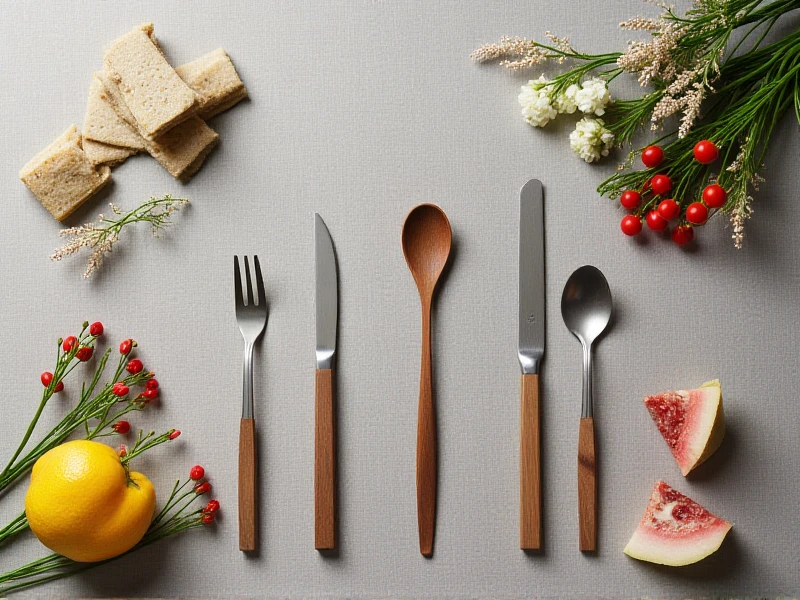Utensils Unveiled: Your Essential Guide to Selecting & Using Kitchen Tools
2025-06-05

Here is an SEO-optimized article focusing on "Utensils":
The humble utensil is the unsung hero of every successful meal. Often overlooked, these essential tools bridge the gap between raw ingredients and delicious dishes. Whether you're a novice cook or a seasoned chef, having the right utensils within reach transforms cooking from a chore into a joy. This guide delves into the fascinating world of utensils, exploring essential types, materials, and tips to optimize your kitchen arsenal.
Beyond the Spoon: Defining Utensils
At its core, a utensil is any hand-held tool used for practical cooking, baking, serving, and eating tasks. Utensils encompass a vast range:
1. Prep Utensils: Knives, peelers, graters, zesters, garlic presses, and mandolines get you started.
2. Cookware Utensils: Spatulas (slotted, flipping, offset), spoons (solid, slotted), ladles, whisks, tongs, and pots/pan handles require heat-resistant tools.
3. Baking Utensils: Rolling pins, dough scrapers, pastry brushes, sifters, and cookie cutters.
4. Serving Utensils: Spoons, forks, cake slices, salad tossers, and gravy boats.
5. Specialty Utensils: Fish slices, corn butterers, melon ballers – solving unique culinary challenges.
Material Matters: Selecting the Right Utensil
The material of a utensil impacts its performance, durability, and safety:
Wooden Utensils: Classic, beautiful, heat-resistant, and gentle on cookware finishes (great for non-stick cookware). Require hand-washing and occasional oiling to prevent cracking. Best for stirring, mixing, scraping. Birch and bamboo are popular sustainable choices.
Silicone Utensils: Highly versatile, heat-resistant (often up to 500°F/260°C), flexible, non-scratch, non-stick, and easy to clean. Ideal for high-heat cooking and non-stick pans. Look for high-quality, food-grade silicone.
Stainless Steel Utensils: Durable, strong, sanitary, and dishwasher safe. Perfect for tasks requiring rigidity like heavy-duty stirring, flipping, or skimming. Can scratch delicate cookware surfaces unless coated (nylon tips are common).
Nylon Utensils: Heat-resistant, inexpensive, lightweight, non-scratch (typically safe for non-stick), and often dishwasher safe. Good for general stirring and serving. Opt for reinforced nylon for longevity.
Plastic Utensils: Affordable but generally lower quality than silicone or nylon. Less heat resistant and can melt. Best suited for serving cold foods.
Copper & Aluminum Utensils: Primarily for whisks (excellent heat conductivity), but require care as they can react with acidic foods.
Choosing the Perfect Utensil: Consider Function and Cookware
Don't just fill a drawer; build a functional collection. Ask: What dish am I making? What cookware am I using? An elegant salad calls for different utensils than briskly stirring a hearty stew.
Non-Stick Cookware: Mandates non-scratch options like wood, nylon, or silicone. Avoid metal utensils at all costs.
Cast Iron & Stainless Steel: Can handle metal utensils with durability, though silicone, wood, and nylon remain excellent choices.
Enameled Cookware: Best paired with wood, silicone, or nylon to preserve the finish.
Essential Utensils for a Functional Kitchen
While preferences vary, these fundamental utensils form a solid foundation:
Chef's Knife: The undisputed champion of prep.
Vegetable Peeler: Effortless peeling.
Can Opener: For pantry staples.
Wooden Spoon: Gentle, versatile for stirring, scraping, sauteing.
Slotted Spoon: Essential for draining pasta or retrieving solids from liquid.
Solid Spoon: Stirs sauces, mixes batters.
Flipping Spatula/Turner: For pancakes, eggs, burgers.
Mixing Spoon Spatula (Spoonula): Silicone scrapes bowls clean effortlessly.
Tongs: Gripping, turning, and serving with precision.
Whisk: Creates air, emulsifies, blends thoroughly.
Ladle: Portioning soups and stews.
Measuring Spoons & Cups: Accuracy is crucial.
Corkscrew: Essential for wine lovers.
Peeler: Quick vegetable prep.
Caring for Your Utensils: Ensuring Longevity
Proper care extends the life of your utensils significantly:
Read Manufacturer Instructions: Some recommend hand-washing; others tolerate dishwashers.
Wood: Hand-wash only with mild soap and lukewarm water. Never soak. Dry thoroughly, then occasionally treat with food-grade mineral oil.
Silicone/Nylon: Usually dishwasher safe. Hot water can sometimes cause them to retain odors – soak in vinegar/baking soda solution.
Stainless Steel: Dishwasher safe and sturdy. Hand dry to avoid water spots.
Avoid Extreme Heat/Pot Edges: Don't leave utensils resting in hot pans or on pot rims, especially plastics/nylon.
Inspect Regularly: Look for cracks, deep cuts, warping, or discoloration indicating replacement time. Damaged surfaces harbor bacteria.
Trends: Function Meets Sustainability
Modern utensil design emphasizes:
Multifunctionality: Tools designed to handle multiple tasks.
Ergonomics: Comfortable handles reducing fatigue.
Eco-Consciousness: Surge in bamboo, certified wood, and recycled silicone. Replacing cheap plastic sets with durable pieces reduces waste.
Innovative Silicone: Colors, shapes, textures, and enhanced heat resistance.
Maximizing Your Utensil Collection
Investing in quality utensils enhances cooking efficiency and enjoyment. Start with the essentials based on your cooking style. Think about how they feel in your hand – the heft of a solid knife, the warmth of a wooden spoon, the flexibility of silicone. Maintain them well, and they'll serve you reliably for years to come. Ultimately, the best utensils aren't necessarily the most expensive but the ones you reach for again and again to effortlessly create delicious food. Build your collection thoughtfully, treat them with care, and let these indispensable tools refine your culinary journey.
Category: